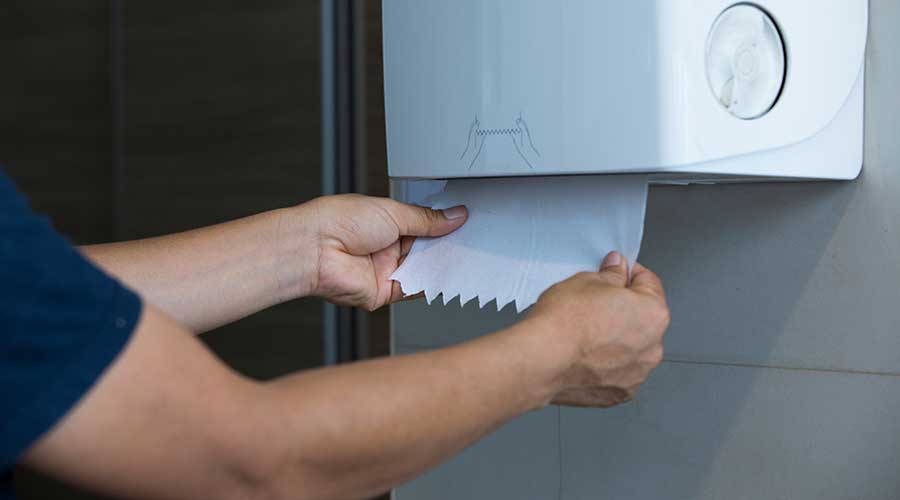Towel dispensers have had a recent resurgence over the last few years due to growing concerns surrounding the COVID-19 pandemic. With public pleas for proper handwashing to help stop the spread of the virus, towel dispensers were back in high-demand – but did they ever leave? Healthcare Facilities Today talks with leading towel dispenser manufacturers on how the pandemic changed their products are used and what we can expect in the future.
How has the COVID-19 pandemic changed the way towel dispensers are used?
“As a result of the COVID-19 pandemic, leaders and influencers from the private and public sector helped raised awareness of the benefits of proper hand hygiene to stop the spread of the virus. As the population became more aware and their habits shifted, we saw an increase in the frequency of hand washing and drying. This then drove a higher towel consumption per person. A survey commissioned by Tork in 2021 revealed that 68 percent of respondents agreed or strongly agreed with the statement, ‘I wish more facilities offered paper hand towels as an alternative to air dryers.’ Forty-one percent agreed or strongly agreed with the statement, ‘I am less likely to go to places that do not offer proper hand towels as a hand drying alternative.’
With less staff, managers of facilities had to rely on solutions that were more efficient. Thus, we also saw a shift towards dispensers that had larger capacity and were easier to refill and maintain. In addition, we saw more demand for one-at-a-time towel dispensers so users only touched what they used, reducing the risk of cross-contamination.
Because people also feared the risk of contracting the virus via surfaces, we noticed more hand towels being used as an additional protective barrier when engaging with high touch surface areas like doorknobs, door pulls and handrails. Our survey shows that 73 percent of respondents agreed or strongly agreed with the statement, ‘I use paper hand towels to avoid touching different surfaces in public restrooms.’"
- Marika White, Tork Hygiene Advisor, Essity
“Prior to the COVID-19 pandemic, conversations around hand hygiene focused almost exclusively on hand washing as a general way to stay healthy, particularly during cold and flu season. But when COVID was in its early stages, GP PRO, global and national health organizations, and many others, worked diligently to communicate that while hand washing is a critical component of proper hand hygiene, so is reducing the number of potentially germy touchpoints individuals come in contact with and drying hands completely after washing them. As a result, COVID was really a singular global event that put a spotlight on touchless towel dispensers, taking them from what was previously a ‘nice to have’ to a ‘need to have’ due to the significant hygiene benefits they offer.
Putting that in perspective, in 2020 and 2021, GP PRO saw surging demand for touchless dispensers, creating the highest levels ever in the history of touchless dispensing. In fact, our own market research showed touchless paper towel dispenser demand was 20 percent to 25 percent higher than pre-COVID. We believe these purchases were mostly to replace paddle or crank-driven units and folded towel dispensers.”
- Julie Howard, vice president and general manager of GP PRO’s Towel and Napkin categories
“The COVID-19 pandemic has increased the awareness of the importance and need for hand washing. The Center for Disease Control and local public health organizations have placed a public and personal health priority on frequent, thorough hand washing as a personal protection behavior to defend against transmission of COVID-19. People are washing their hands more frequently now than ever before at home and away from home. Effective hand washing includes thorough drying of hands. Paper towels are the most effective way to remove all water and moisture from hands. Moisture-free hands prevent the growth and spread of bacteria.”
- Alan Gettelman, vice president – external affairs, Bobrick Washroom Equipment Inc.
Mackenna Moralez is the associate editor for the facility market.

 Healthcare Is the New Retail
Healthcare Is the New Retail Bridgeway Behavioral Health Services Launches Campaign to Renovate Health Center
Bridgeway Behavioral Health Services Launches Campaign to Renovate Health Center Ground Broken for New North Dakota State Hospital
Ground Broken for New North Dakota State Hospital AI Usage for Healthcare Facilities
AI Usage for Healthcare Facilities Ground Broken on Pelican Valley Senior Living Modernization Project
Ground Broken on Pelican Valley Senior Living Modernization Project